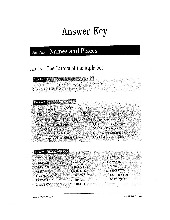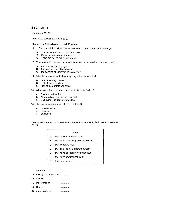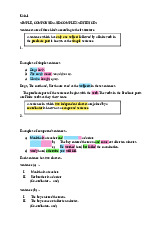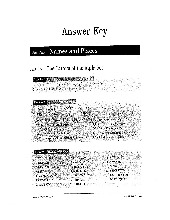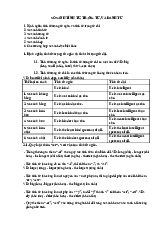
















Preview text:
lOMoAR cPSD| 40342981
Test format – Listening (30 minutes)
Timing: Approximately 30 minutes (plus 10 minutes transfer time). No. of questions: 40
Task types: A variety of question types are used, chosen from the following: multiple choice,
matching, plan/map/diagram labelling, form/note/table/flow-chart/summary completion, sentence completion.
You will listen to four recordings of native English speakers and then write your answers to a series of questions.
● Recording 1 – a conversation between two people set in an everyday social context.
● Recording 2 – a monologue set in an everyday social context, e.g. a speech about local facilities.
● Recording 3 – a conversation between up to four people set in an educational or training
context, e.g. a university tutor and a student discussing an assignment.
● Recording 4 – a monologue on an academic subject, e.g. a university lecture.
Question types in the Listening test 1.
Multiple choice questions 1 lOMoAR cPSD| 40342981 2. Matching questions 3.
Map labelling questions 2 lOMoAR cPSD| 40342981 4. Completion questions 3 lOMoAR cPSD| 40342981 4 lOMoAR cPSD| 40342981 Note-taking 1. Why Note-taking?
Note-taking is a crucial skill that can help you succeed in the IELTS listening test, as it allows you
to actively engage with the audio and retain important information.
The fact that you may only listen to the audio once during the Listening exam is the greatest
challenge for each candidate. Additionally, during the test, applicants will be required to listen to
several recordings, many of which include material that is spoken quickly. As a result, you won't
be able to listen to any missed material from the listening exam again. Candidates therefore need
to take notes (in shorthand) throughout the listening test in order to "store" the key information or
concepts in order to provide the most exact answers. The procedures for using the note-taking
strategy in IELTS Listening - Multiple Choice format will be covered in the following article. 2. About Note-taking 1.
Taking notes (shorthand) involves quickly writing down information heard during the IELTS Listening test. 2.
The note-taking technique is crucial in IELTS Listening as it allows candidates to identify
the main idea of the question, increasing the likelihood of selecting the correct answer without
having to read the questions and listen to the recording at the same time. 3.
When taking notes in IELTS Listening, candidates should focus on key information such
as nouns, adjectives, and verbs, and use abbreviations and symbols to save time. It is also
recommended to take notes in native language (Vietnamese). 4.
The following steps can be used when taking notes during an IELTS Listening Multiple Choice question:
- Step 1: Identify and underline keywords in the question and answer options.
- Step 2: Listen carefully to the audio and take notes using shorthand.
- Step 3: Compare the notes taken with the question and answer options to choose the correct answer. Notes on taking notes
Candidates need to spend a lot of time practising the skill of taking notes in order to keep up with
the recording because some recordings have fairly quick speaking paces. This also helps
candidates improve their listening and writing reflexes.
Words to take notes: Noun, Adjective, and Verb
Focus on content words, which are those that are important to understanding the meaning of the
sentence. - noun/ verb phrases, adjectives, adverbs (including words indicating time) time,
place), negative words (not, never, rarely, barely, but, …), words indicating the sequence of
actions (originally, first, final, next, ...)
Function words, such as the articles the, a, and an; prepositions in, on, and; and auxiliary verbs
do, does, did, should be ignored.
Abbreviations and symbols in note-taking 5 lOMoAR cPSD| 40342981
To improve your note-taking skills, it is important to practise actively listening while taking notes,
and to develop your own shorthand system that works for you. You should also familiarise
yourself with common abbreviations and symbols used in note-taking as you can save time and
keep up with the listening (write numbers or use symbols to describe the increasing or decreasing trend).
Here are some common abbreviations you can use when taking notes during the IELTS listening test: - w/ - with - w/o - without - b/c - because - e.g. - for example - i.e. - that is - approx. - approximately - info - information - gov - government - yrs - years - min - minutes - max - maximum - km - kilometres - ft - feet - incl. - including - excl. - excluding
Remember, the key is to develop a system of abbreviations that works for you and that you can
use consistently. This will help you take notes more efficiently and save time during the exam.
Using Vietnamese language to take notes
Be ready to take notes in Vietnamese in case the candidate is uncertain whether the word is spelled
correctly or not since the goal of taking notes is merely to help the candidate remember the main idea of the recording.
By practising your note-taking skills and actively engaging with the audio, you can improve your
chances of success on the IELTS listening test. Remember to stay focused and organised, and to
use your notes as a valuable resource throughout the exam.
3. Common mistakes to avoid when taking notes 1.
Writing too much: It's important to write down key information, but avoid writing down
everything you hear. Focus on the most important details, such as dates, names, and locations. 2.
Not organising your notes: Organising your notes is important to help you understand
the flow of the audio and find information quickly. Use headings, bullet points, and columns to keep your notes organised. 3.
Not using abbreviations: Abbreviations can save time and help you take notes more
efficiently. Develop a system of abbreviations that works for you, and make sure you're consistent in using them. 6 lOMoAR cPSD| 40342981 4.
Not listening actively: It's easy to get distracted or lose focus during the exam, but
actively listening is essential for taking effective notes. Stay focused and engaged, and make sure
you're actively listening for key information. 5.
Not reviewing your notes: Reviewing your notes is important to ensure that you've
captured all the important details. Take a few seconds to review your notes after each section of
the audio to make sure you haven't missed anything. 6.
Not leaving enough space: Leave enough space between your notes to add additional
information or make corrections later on.
By avoiding these common mistakes and practising your note-taking skills, you can improve your
chances of success on the IELTS listening test.
4. Note-taking application in the IELTS Listening for Multiple choice questions
Pre-listening: Underline keywords in the question and answers
For this type of question, it is important to spot the differences between the options in order to
choose the correct one. In doing so, candidates can easily identify the keywords for listening but
remember to choose 1, or 2 keywords since it may be confusing if there are many underlines
While-listening: Listen and take notes
At this stage, candidates should not pay all attention to the answers since keywords in the 4 options
could all be mentioned as distractors to lure you into the incorrect option. The “real” keyword can
be paraphrased into something else so it is better to listen for comprehension and take notes as you listen.
Post-listening: Compare the notes taken with the 4 options
After each listening section, half a minute will be given for checking what candidates have just
listened. It is time for comparing the notes and options in the question to find out the correct one.
(Cambridge IELTS 11, Test 3) - CHANGES IN BARFORD OVER THE LAST 50 YEARS 7 lOMoAR cPSD| 40342981 SECTION 2 Questions 11 – 15
Choose the correct letter, A, B or C.
11 In Shona’s opinion, why do fewer people use buses in Barford these days
A The buses are old and uncomfortable.
B Fares have gone up too much.
C There are not so many bus routes.
12 What change in the road network is known to have benefited the town most?
A the construction of a bypass
B the development of cycle paths
C the banning of cars from certain streets
13 What is the problem affecting shopping in the town centre? A lack of parking spaces B lack of major retailers
C lack of restaurants and cafés
14 What does Shona say about medical facilities in Barford? A There is no hospital.
B New medical practices are planned.
C The number of dentists is too low.
15 The largest number of people are employed in A manufacturing. B services. C education. Explanations: Step 1 Step 2 and 3 8 lOMoAR cPSD| 40342981
1. In Shona’s opinion, why do fewer people use buses in
Đại ý câu hỏi: tại sao ít người dùng Barford these days? xe buýt ngày nay?
A. The buses are old and uncomfortable. Bước 2:
B. Fares have gone up too much.
Most people - use - frequently - but
C. There are not so many bus routes. not now because - companies concentrate - routes - most
Script: Fifty years ago, buses linked virtually every part of passengers. Parts of town - no longer
the town and the neighbouring towns and villages. Most served by buses.
people used them frequently, but not now because the bus Replace - old bus - with new one
companies concentrate on just the routes that attract most
little impact - passenger numbers.
passengers. So parts of the town are no longer served by
Fare - too high, but - to - income, buses.
fare - not higher than - 50 yrs ago.
Even replacing old uncomfortable buses with smart new
Bước 3: Ghép từ khóa lại: Hầu hết
ones has had little impact on passenger numbers. It’s
mọi người đều sử dụng xe buýt
sometimes said that bus fares are too high, but in relation to thường xuyên, nhưng không phải
average incomes, fares are not much higher than they were ngày nay. Bởi vì công ty chỉ tập 50 years ago.
trung vào tuyến đường nhiều khác.
Cho nên một phần thị trấn không còn xe bus nữa. => Chọn C
Việc thay thế xe buýt cũ bằng xe
mới, ít ảnh hưởng tới số lượng khách. => Loại A
Giá vé có tăng, nhưng đối với mức
lương, thì nó không quá tăng cao so
50 năm trước. => Loại B 9 lOMoAR cPSD| 40342981
2. What change in the road network is known
Đại ý câu hỏi: Sự thay đổi nào trong
to have benefited the town most? A. the
hệ thống đường mang lại lợi ích construction of a bypass nhiều nhất?
B. the development of cycle paths
Bước 2: Centre - closed - traffic
C. the banning of cars from certain streets
making - much safer - pedestrians.
Script: Changes in the road network are affecting the town. Impact of this - being measured.
The centre was recently closed to traffic on a trial basis,
New cycle path - separate - bike
making it much safer to pedestrians. The impact of this is
from car - ↓ traffic - ↑ air quality. being measured. Council - attempt - bypass
The new cycle paths separating bikes from cars in most constructed - failed.
main roads are being used far more than was expected, Bước 3:
reducing traffic and improving air quality.
Trung tâm đã đóng cửa với giao
And although the council’s attempts to have a bypass
thông (không cho giao thông qua
constructed have failed, we haven’t given up hope of
lại), làm an toàn hơn cho người đi
persuading the government to change its mind.
bộ. Tác động của việc này đang được xem xét.
=> Centre = certain streets.
=> Closed - traffic = banning of cars.
Tuy nhiên không đề cập rõ là việc
này có lợi nhiều hơn hại hay ngược
lại mà chỉ đang xem xét. => Loại C
Cycle paths được chia ngăn cách xe
đạp và ô tô. Điều này làm giảm kẹt
xe và tăng chất lượng không khí.
=> Việc này có lợi rõ ràng => Chọn B
Hội đồng cố gắng xây bypass nhưng thất bại. => Loại A 10 lOMoAR cPSD| 40342981
3. What is the problem affecting shopping in the town centre? Đại ý câu hỏi: Vấn đề ảnh hưởng tới A. lack of parking spaces việc mua sắm. B. lack of major retailers Bước 2:
C. lack of restaurants and cafes
Numbers - falling - despite efforts
Script: Many of us can remember when the town was open new car parks.
crowded with people going shopping.
Some people - combine - shopping
Numbers have been falling for several years, despite efforts restaurants and cafés.
to attract shoppers, for instance by opening new car parks. Most shops - small - good, but many
Some people combine shopping with visits to the town’s
people - prefer - supermarkets - as so
restaurants and cafés. Most shops are small independent
few well-known chain stores here.
stores, which is good, but many people prefer to use Bước 3:
supermarkets and department stores in nearby large towns, Số lượng khách giảm đi mặc dù nỗ
as there are so few well-known chain stores here.
lực mở thêm bãi đổ xe.
=> Việc thiếu bãi đỗ xe không phải
là vấn đề => Loại A
Một vài người kết hợp việc đi mua
sắm và đi nhà hàng và quán cà phê.
=> Việc thiếu nhà hàng và quán cà
phê không phải là vấn đề => Loại C
Nhiều shops nhỏ nhưng tốt, tuy
nhiên nhiều người thích đi siêu thị
hơn bởi vì có ít thương hiệu nổi tiếng ở đây (centre). => Chọn B
4. What does Shona say about medical facilities in Barford? Đại ý câu hỏi: Shona nói gì về cơ sở A. There is no hospital. y tế?
B. New medical practices are planned.
Bước 2: Town - served - family
C. The number of dentists is too low
doctors - in several - practices -
Script: Turning how to medical facilities, the town is served fewer than 50 years ago. hospital -
by family doctors in several medical practices – fewer than closed 15 years ago. More dentists
50 years ago, but each catering for far more patients. Our than - used to be.
hospital closed 15 years ago, which means journeys to other Bước 3: towns are unavoidable.
Thị trấn được phục vụ bởi các bác sĩ
On the other hand, there are more dentists than there used to gia đình trong một số cơ sở y tế - be.
cách đây chưa đầy 50 năm.
=> Không có kế hoạch xây dựng cơ
sở y tế mới. => Loại B
Bệnh viện đóng cửa 15 năm trước. => Chọn A
Nhiều nha sĩ hơn trước. => Loại C 11 lOMoAR cPSD| 40342981
5. The largest number of people are employed in
Đại ý câu hỏi: Số lượng lớn nhất dân A. manufacturing. cư làm việc trong B. services.
Bước 2: Number - schools + colleges C. education. - increased making - main
Script: Employment patterns have changed, along with employment sector. Services -
almost everything else. The number of schools and colleges grown. Manufacturing hasn’t seen
has increased making that the main employment sector. the decline.
Services, such as website design and accountancy, have
Bước 3: Số lượng trường học và
grown in importance, and surprisingly, perhaps,
trường đại học (education: giáo dục)
manufacturing hasn’t seen the decline that has affected it in tăng, làm lĩnh vực lao động chính. => other parts of the country. Chọn C
Ngành dịch vụ tăng, ngành sản xuất không thấy giảm.
=> Chỉ nói tới xu hướng của ngành
dịch vụ và sản xuất. Chứ không đề
cập đến đây có phải là lĩnh vực có
lực lượng lao động cao nhất hay không. => Loại A và B.
5. Note-taking application in the IELTS Listening for Matching questions
In Matching question, you will be given a list of items and a set of possible answers. Your task is
to match the items with the correct answers based on the information you hear in the audio
recording. To effectively match the items with the correct answers in this question type, you
should take notes while listening to the recording. Make sure to pay attention to key words and
phrases, as well as any numbers or dates that may be mentioned. (Cambridge IELTS 14, Test 1) 12 lOMoAR cPSD| 40342981
Pre-listening: It is advisable that you should read both the question and answer lists to get the
overall idea about the task, as to make it easier for you to take notes.
=> The question asks you about the aspects of the company policy for apprentices (những khía
cạnh liên quan đến chính sách dành cho người học việc của công ty.)
This is the main idea of this recording and candidates are advised to understand and identify the
key information in the question and answer lists. Please be aware of synonyms, or paraphrases
that might appear in the audio.
While-listening: Once you get the general idea about the text, you should then take notes as you
listen. The information will be mentioned in orders and you should take notes accordingly. Note-taking examples
Q15: I just want to run through a few company policies for our apprenticeship scheme with you…
Most importantly, the internet. As part of your job you’ll be doing some research online so
obviously you’ll have unlimited access for that but please don’t use it for personal use – you’ll
have your own phones for that.
=> The internet – do research online – unlimited access- don’t personal use
Q16: Some of you have already asked me about flexible working. After your probationary three-
month period – some of you will be eligible for this – but it will depend on which department
you’re in and what your personal circumstances are. So please don’t assume you’ll automatically be permitted to do this.
=> Flexible working – after 3 months – eligible – depend on depth & personal circumstances Q17:
I want to make sure there’s no confusion about our holiday policy. Apart from any statutory public
holidays we ask that you don’t book any holidays until after your six-month apprenticeship has
finished. Time off should only be taken if you are unwell. Please speak to your supervisor if this is going to be a problem.
=> Apart from public holidays – don’t book holidays- after 6 months – time off when unwell 13 lOMoAR cPSD| 40342981
Q18: You’ll be expected to work a 40-hour week but there may be opportunities to do overtime
during busy periods. Although you’re not required to do this, it can be a valuable experience – so
we advise you to take it up if possible. Obviously, we understand that people do have
commitments outside work, so don’t worry if there are times when you are unavailable.
=> Opportunity do overtime – valuable exp – advise take it up
Q19: As you know, we don’t have a formal dress code here – you may wear casual clothes as long
as they’re practical – and the only restriction for shoes we have is on high heels for health and
safety reasons. Comfortable shoes like trainers are preferable.
=> Don’t have formal codes – Wear casual- no heels- trainers preferable
Q20: There’s a heavily subsidised canteen on site where you can get hot meals or salads cheaply.
Snacks and drinks are also provided – so (Q20) we’ve decided to introduce a no packed lunch
policy. This is partly to encourage healthy eating at work and partly to stop people from eating at
their workstation, which is unhygienic.
=> Canteen hot meals, snacks & drinks – no packed lunch policy- encourage healthy eating Post-
listening: in this stage, you should compare your notes to the answers to choose the correct one.
Q15: Người quản lý trong audio giới thiệu về internet trong việc làm nghiên cứu trên mạng. Tuy
việc này sẽ không giới hạn trong việc truy cập nhưng quản lý cũng nói thêm rằng việc sử dụng
internet không phục vụ cho việc sử dụng cá nhân. => B
Q16: Đề bài đã đánh lừa khi nhắc đến việc sau 3 tháng thì người học việc có thể linh hoạt trong
giờ làm nhưng người học cần lưu ý vì người quản lý cũng nói thêm là điều đó sẽ tùy thuộc vào
phòng ban đang làm và tình huống cá nhân. => B
Q17: Quản lý đã trực tiếp nhắc đến việc ngoại trừ các kì nghỉ công cộng thì người học việc
không đặt các chuyến du lịch nghỉ lễ sau 6 tháng thử việc và chỉ khi nào người học việc cảm
thấy không khỏe thì mới có thể xin nghỉ. => C
Q18: Việc làm ngoài giờ được xem là một cơ hội để có thêm kinh nghiệm quý giá và quản lý cũng
khuyên người học việc nên làm việc ngoài giờ. => A
Q19: Quản lý đã cho biết ở công ty không có quy định ăn mặc trang trọng mà có thể ăn mặc
bình thường. Và việc duy nhất bị cấm ở đây là mang giày cao gót và người quản lý cũng khuyến
khích mang giày thể thao. => A
Q20: Công ty sẽ có căn-tin phục vụ thức ăn nóng, đồ ăn vặt và thức uống cho nên việc đem đồ ăn
trưa là không được cho phép. => C
In short, utilising note-taking skills in the IELTS Listening test can help test-takers in preventing
the omission of crucial information during the listening phase and enable them to compare their
recordings with the answer choices when the listening is over. As a result, candidates can provide
more precise answers. However, regular practice to be familiarised with this technique are
necessary for candidates to attain favourable results as they enhance their listening proficiency. 14 lOMoAR cPSD| 40342981
UNIT 1: SPELLING AND NUMBERS
Exercise 1 Listen and write the letters you hear.
1. ................. 4. ..................
2. ................. 5. ................... 3. .................
Exercise 2 Listen to five short conversations and complete notes 1-5 with
NO MORE THAN ONE WORD AND/OR A NUMBER 1. Name Mr Andrew 2. Address: 63 Road, Birmingham
3. Website address: www. .com 4. Meet at the Hotel
5. Registration number:
Exercise 3 Listen and circle the number you hear in each pair. a. 1st/3rd e. 19/90 b. $10.50/$10.15 f. 52/62 c. 6th/5th g. £110/£810 d. 17/70 h. 22nd/27th
Exercise 4 Listen to the next part of conversation 1 and choose the correct answer.
1. How many people does the woman want to make the booking for? A. 8 B. 12 C. 16
2. What is the date of the booking? A. 12th B. 16th C. 17th
Exercise 5 Now listen to the rest of the conversation and choose the correct answer.
How much is the total cost of the booking? A. £218 B. £318 C. £380
Exercise 6 Listen to the second part of conversation 2 and answer the questions.
1. The price of the earrings now is... A. £10 B. £20 C. £30
2. How much does the customer pay for the gift wrapping?
A. £4 B. £5 C. £7
Exercise 7 Listen again and complete this part of the conversation. 15 lOMoAR cPSD| 40342981
Customer Oh, really? So, how much are they?
Assistant Well, they were 1...........pounds, but actually, we’ve got a sale on at the
moment, so they’re a little cheaper - only 2..........pounds. So you can save 3............pounds! ❖ Home Practice
Exercise 1. Listen and repeat the names of these letters. A E I S
Exercise 2. Now listen to these letters and put them in the correct column according
to how we pronounce their names.
C F G H J K L N O R T U V W X Y
Four of the letters don't fit in any of the columns. Which are they?
Exercise 3. Listen to some words being spelt out and write down what you hear.
Read the word you have written. Can you say it? If not, maybe you missed a vowel!
1. Address: 2323......................Road 2.
Name of company: ...................Limited
3. Name: Anna.............................
4. Meeting place:............................School
5. Name of village: ..........................
6. Website address: www......................com
Exercise 4. Listen to these sentences and write the number you hear in the gaps. 16 lOMoAR cPSD| 40342981
1. ........................ King Street
2. Family ticket costs $ ............................
3. Mobile phone number: ........................
4. Theatre opened in ................................
5. Secretary is in Room .............................
6. Cost of flight: £ ....................................
Exercise 5. Listen to these sentences and write the dates you hear in the gaps.
1. The course begins on................................
2. Date of birth: ..................................
3. Date of appointment: .................................
4. The wedding will take place on ..............................
5. Date of arrival in New York: ....................................
6. Date of interview: ..................................
Exercise 6. Listen to these sentences and write the measurement you hear in the gaps.
1. Mount Everest is..................high.
2. Distance from Wellington to Auckland: ...........................
3. John's height:................................
4. Add.......................flour to sugar.
5. Weight: ........................
6. Width of desk: ............................. 17
